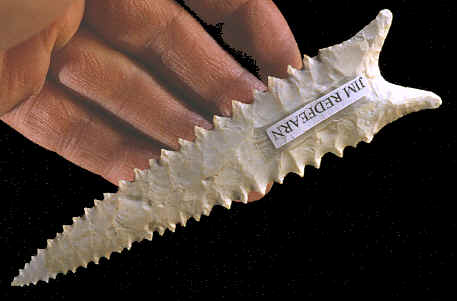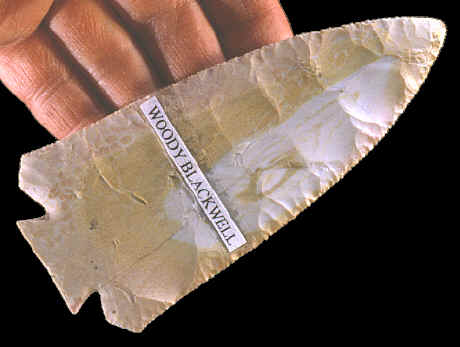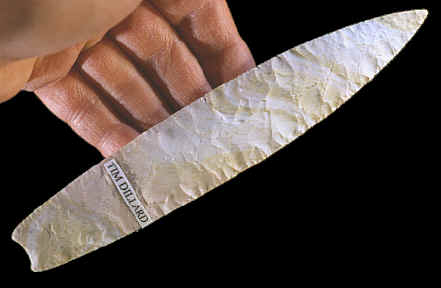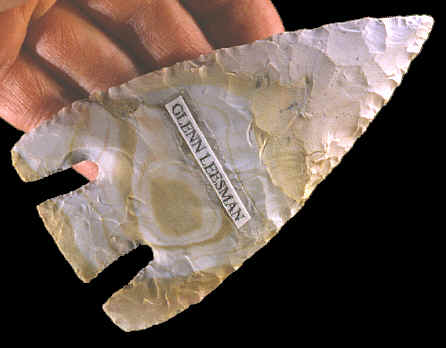|
PAGE
2 CONTINUED
FROM PAGE 1
14 POINTS
FROM 1 HIGH RIDGE CHERT NODULE
BY 9
DIFFERENT FLINT-KNAPPERS
PAGE 2 OF 3 PAGES
COPYRIGHT
JUNE 31, 2004 PETER A. BOSTROM

DALTON
POINT BY JIM REDFEARN
BRIAN WRAGE COLLECTION
Jim chose to make a Dalton point from his piece of High Ridge
chert. He made a stylish "spike-edged" Early Archaic
type Dalton point. It measures 5 1/8 inches (13cm) long.
|
|
|
The High Ridge chert from which these points were made was used in its raw
state. It was not heat treated. The chert in this nodule was
colorful enough without heating. Heat treating will sometimes bring out
more colors in the stone and also make it easier to flake.
|
|

FRACTURED
BASE DECATUR POINT BY WOODY BLACKWELL
BRIAN
WRAGE COLLECTION
Woody made this very thin fractured base Decatur point. These types
of points are unique for their squared ended bases. Instead of
grinding the base smooth for hafting like most other Early Archaic
points these were smoothed on the base by removing two small flakes
from the corners toward the center. This is a good artistic example.
It measures 4 7/7 inches (12.3cm) long and 2 1/4 inches (5.6cm)
wide. |
|
|
The
fourteen points illustrated in this article were made by nine different flint-knappers.
Each of them has been knapping for many years.
|
|

AGATE
BASIN POINT BY TIM DILLARD
BRIAN
WRAGE COLLECTION
Tim is known for his ability to make a very wide range of point
types. This Agate Basin point with a concave base is one
example. This point is the second longest one in this
collection of points. It measures 7 inches (17.8cm) long. |
|
|
The names of
the people who made these points are Woody Blackwell, Tim Dillard, Ted
Franks, Glen Leesman, Roy Miller, Mark Nation, Jim Redfearn, Jim Spears
and Brian Wrage.
|
|

CALF
CREEK POINT BY GLEN LEESMAN
BRIAN
WRAGE COLLECTION
Glen made this nice basal notched Calf Creek point. Calf Creek
points are knife forms that date to the Early Archaic period. This
one measures 4 1/2 inches (11.4cm) long and 2 3/8 inches (6cm) wide. |
|
|
Some of the
flintknappers whose work is represented in this group of points are
considered by many to be among the most highly skilled knappers in the
world. Some of them do it as a hobby while others have developed it into
more of a vocation.
|
|
CONTINUE ON TO PAGE
THREE
|
|
"REFERENCES"
1994,
Whittaker, John C., "Flintknapping: Making & Understanding Stone
Tools," p.61.
2004,
Whittaker, John C., American Flintknappers: Stone Age Art In The Age Of
Computers," p.34.
Personal communications with Brian Wrage.
|
|
HOME
ORDERING |



